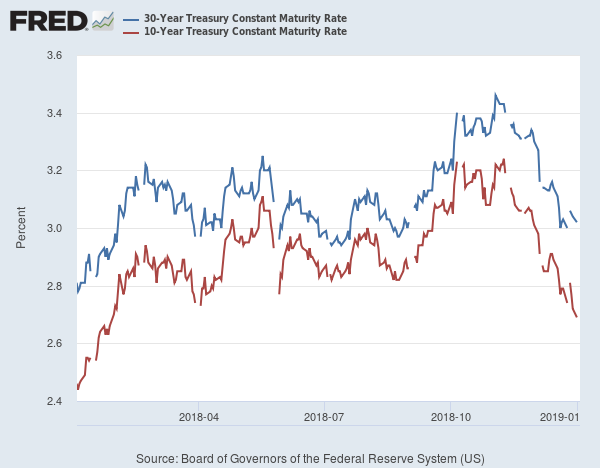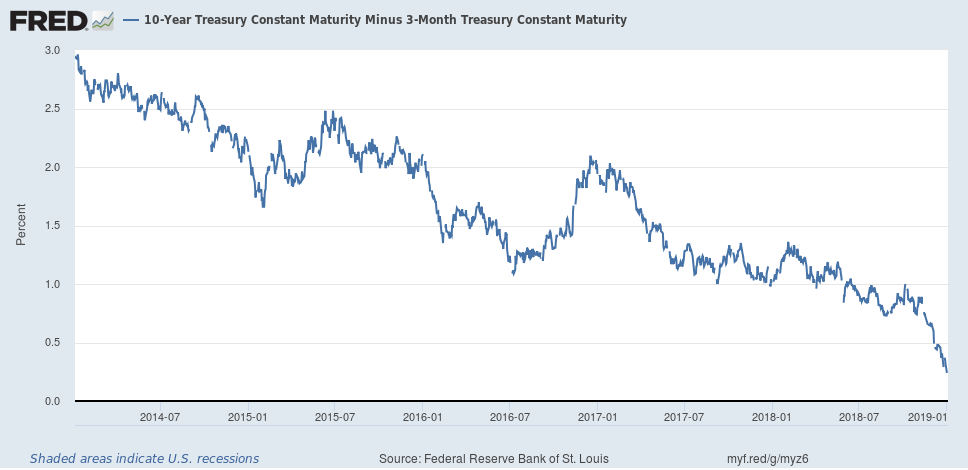Summary
- Fed Chairman Powell got the message from the markets.
- Other Fed governors are now taking a wait and see attitude.
- This is good, because the yield curve continues to narrow.
As we start a new year, the central question is will the Fed change course and slow or even drop its pace of rate increases. This week, several Fed Presidents offered their respective opinions indicating that was a distinct possibility.
Fed President Powell spoke at an economics convention on Friday. He made two very important statements. First, he said he would not resign if asked to by the President. This helped to quell market concerns about the potential conflict between the President and the Fed Chair. Second, he stated the Fed may be pausing in its assessment of the economy and interest rates (emphasis added):
Jerome H. Powell, the Federal Reserve chairman, said on Friday that low inflation would allow the Fed to be “patient” in considering whether to continue raising its benchmark interest rate, giving the central bank more time to assess whether economic growth is slowing and helping to calm jittery financial markets.
This is a very encouraging development. Many commentators (myself included) have argued that the Fed's projected policy rate increases for 2019 were not warranted when considered against a backdrop of slowing global growth and increased uncertainty caused by trade tensions. It appears the Fed has gotten the message from the markets and could be altering course accordingly.
Dallas Fed President Kaplan - a non-voting president - is calling for a pause in rate hikes. From CBS MarketWatch:
“We shouldn’t be taking further action until some of these uncertainties resolve themselves, and I think that could take several months,” Kaplan said in an interview on Bloomberg Television.
The Fed can afford to be patient because inflation “is not running away from us,” he said.
Central to Kaplan's thinking is the recent volatility and drop in the financial markets, which he believes are caused by slowing international growth, tightening credit spreads and a slowdown in interest-sensitive sectors. He also noted that according to Fed projections, interest rate increases will exert a larger slowing influence on the economy in 2019, adding to the slowdown argument.
Richmond Fed President Barkin (another non-voting member) also gave a speech, in which he argued that due to low population and productivity growth, we can expect the U.S. economy to grow at a slower rate over the next 5-10 years. As for current conditions, he noted that (emphasis added):
But as we enter 2019, I hear a lot of concern. Some is environmental, driven by trade or politics. Some is market driven, as volatility has increased and the yield curve has narrowed. Some is margin pressure. But overall, the question I hear most is, “How long can this growth continue?”
In addition to extensive analytical resources, the Fed also has deep ties to their respective communities. They regularly discuss economic developments with community leaders to get their take on the conditions on the ground. Remember: concern prevents activity; if business leaders see too much risk, they'll simply stay the course.
It appears that the Fed is listening to the markets, meaning the program of rate hikes may be on pause for at least the next meeting. That's fortunate because the bond market continues to behave as if this expansion is nearing an end.
First, a bit of history, which this graph illustrates:
Two forces are at play in the standard yield curve inversion. The first is the Fed raising short-term interest rates (above in red). The central bank starts raising rates at some point to either "normalize" interest rates, stave off inflation, or both. Then, towards the end of the expansion, traders start to buy the long-end of the curve, believing (usually correctly) that the Fed has over-tightened, which will lower growth and, subsequently, inflation.
We're starting to see the long-end of the curve come in:

The 10- and 30-year CMT have seen their respective yield decline by around 40 basis points over the last few months. Despite Friday's Treasury market sell-off, this trend is still in play.
As a result, the yield curve continues to narrow:

Given the dovish statements from various Fed governors over the last few days, I wouldn't be surprised to see the curve widen a bit, as the long-end of the curve sells off. However, at some point, the bond market will again focus on slower growth and the resulting lower inflation and start to buy the long-end again.
Disclosure: I have no positions in any stocks mentioned, and no plans to initiate any positions within the next 72 hours. I wrote this article myself, and it expresses my own opinions.

